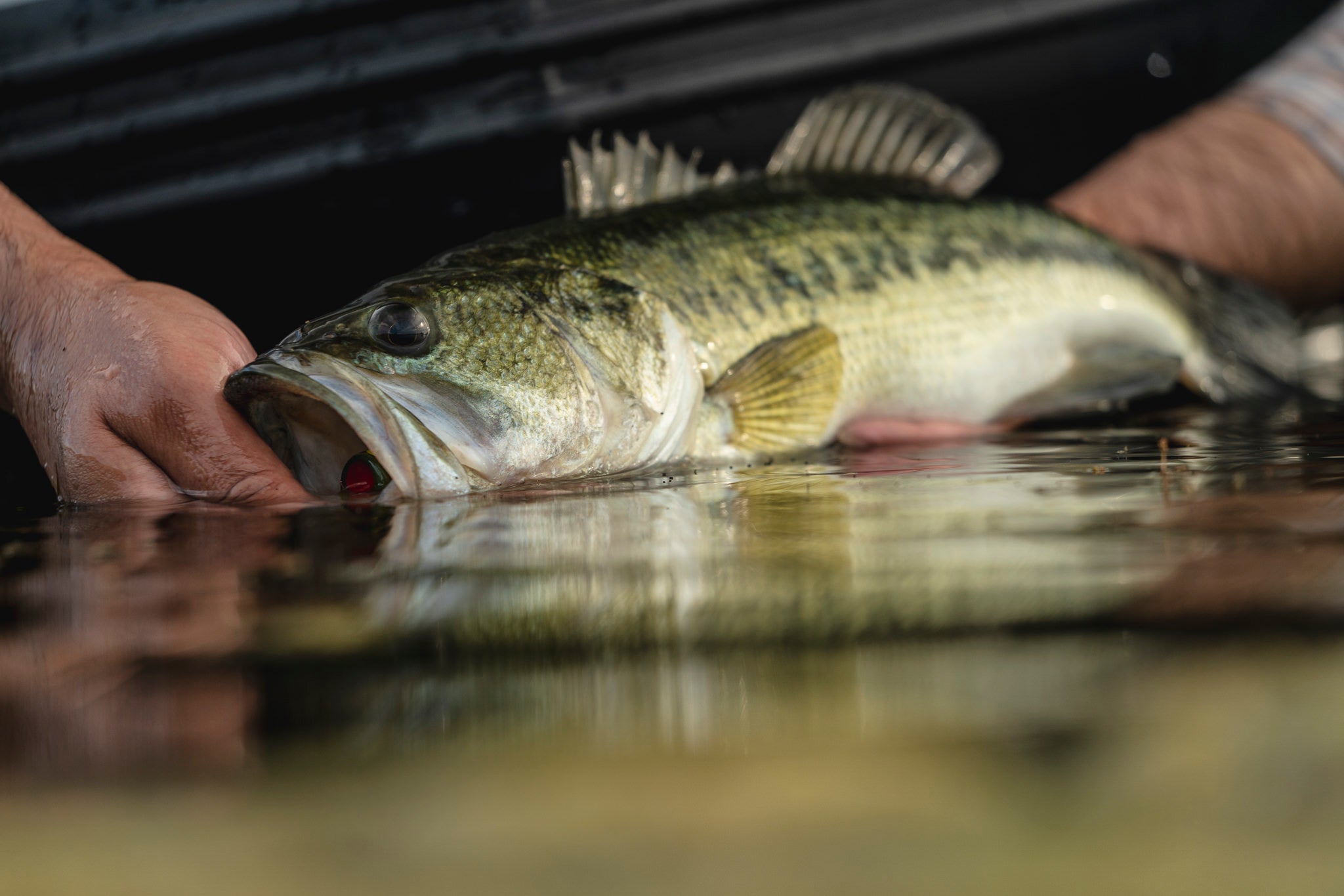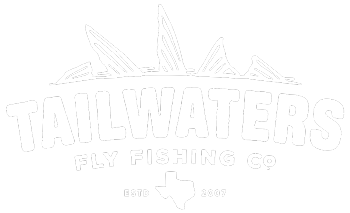
{The Essentials
Fly Fishing for Bass
FLY FISHING FOR LARGEMOUTH BASS
For anglers from California to Florida — and most definitely in Texas — the new year means largemouth bass fishing is just around the corner. Fly fishing for bass in springtime is special for any number of reasons. Most people in the country have bass fishing somewhere in their own neck of the woods; no long-distance travel required. Spring bass fishing means an opportunity to get outside near home, with a front row seat for nature’s annual rebirth. Fresh shades of green everywhere, the first scent of wildflowers, a myriad of mating calls, and a continual chorus of frogs and crickets.
Water temperatures are also on the rise and the fish are waking up and hungry. With few exceptions, spring is easily the best time to bass fish in most locations, both for action and for size. Very often the fish are shallow or surface-oriented, meaning visual takes and topwater action. And, more lunker bass are fooled in the pre-spawn period of early spring than the rest of the year combined.
For all those reasons and more, if springtime largemouth bass fishing is not part of your annual ritual, it should be!
WHAT ARE THE BEST FLIES FOR BASS FISHING?
This is not an easy question to answer since bass live in so many different types of water, from large reservoirs to farm ponds, rivers, sloughs, swamps, water hazards, brackish marshes, canals, and probably many others. Each has a unique mix of food sources. All you have to do is look at the thousands of different types of conventional baits to realize that bass will eat almost anything at the right place and time.
This is true with flies as well; bass will eat flies in many many different patterns, sizes, and colors. So, while there are tried and true favorite bass flies, do not be afraid to mix it up. If you are a fly tier, get creative. If you buy your flies, round out your fly box with variety — for instance topwater bugs or streamers designed for other species. Bass can be finicky; with a wide range of flies you have better odds of having the pattern that works on any given day or showing the fish something they’ve never seen before.
Largemouth bass have a pronounced lateral line and are attuned to sound and vibration underwater. Thus many of the most productive bass flies move a lot of water, like poppers, divers, hollow flies, and articulated flies. But not all effective bass flies fit that mold. Many big bass have fallen for the sleek Clouser minnow.




With that caveat to try a wide variety, here are our go-to bass flies:
- Deer hair poppers and divers – Whitlock’s Hair Bug Size #2 Color- Frog , Rainy’s Joom Diver Size #6 Color – Olive
- Conventional poppers and other surface bugs – Rainy’s Rattlin’ Frog Size #2 Color – Frog, Whitlock’s Ultra Air-Jet Bug Size #1 – Frog
- Hollow flies – Whitlock’s Sheep Minnow Size #6 Color – Shiner, Hud’s Bushwacker Size #1 Color – Bluegill
- Streamers and other baitfish imitations -Bennett’s Lunch Money Size #2 Color – Tan, Hud’s Bushwacker Size 2/0 Color – Purple, Clouser Minnow Size 2/0 Color – Sexy Shad
- Crawfish flies – Whitlock’s Near Nuff Crayfish Size #6 Color – Dirty Olive, Carpenter’s Crayposter Size #2 Color – Orange
- Worm/leech imitations- Barr’s Meat Whistle Size 1/0 Color – Black, Woolly Bugger Size #4 Color – Olive, RJ’s Jiggy Worm Size #1 Color – Olive
- Articulated baitfish – Chocklett’s Finesse Changer Size 2/0 Color – Shad, Chocklett’s Polar Changer Size 4/0 Color – Yellow/Olive
You should have a wide variety of colors, but white, black, green, chartreuse, pink, and natural are all favorites. You should also have flies that will reach multiple depths in the water column, from floaters to flies with a fast sink rate. For optimal results, you should also pair your flies with fly lines . . .
WHAT ARE THE BEST TYPES OF FLY LINES FOR BASS FISHING?
Fly lines are an underrated aspect of bass fishing. Most anglers simply use floating lines. However, when the fish are not keying on the surface, those anglers are probably missing fish by not using intermediate, sink tip, or full sink lines. Floating lines pull subsurface flies upward and potentially out of the strike zone. Even if it may be possible with a floating line to wait and let your fly sink, doing so may result in an ineffective rate of retrieve and give little action to the fly. It is much better to try to find the right water depth with your fly line rather than your fly.
The principle here is not complicated — you should have fly lines that allow you to properly fish all depths of the water you are fishing. If you are fishing a shallow river, you may not need a full sinking line. But if you are fishing a larger, deeper body of water, your full sink line may end up being your primary line. For most anglers, having the right lines means at least one floater, one intermediate or intermediate tip, and one sinking line.
Thinking outside the box can pay off with lines as well as flies. For instance, some poppers are too buoyant to “bite” the water well with a floating line. For such poppers, you can achieve a much better action by using an intermediate or intermediate tip line, which will pull the popper down slightly and cause it to make a bigger pop. Another example is when fishing rivers, you may need to use an intermediate or sinking line even if the water is shallow. With a bit of current and a steady retrieve, your fly will not have a chance to get too deep, so you may need a sinking line to get it into the strike zone.
OUR FAVORITE FLY LINES FOR BASS
Two of our favorite floating lines for bass are the Redfish and SmallMouth tapers from Rio. Both have a heavier front taper that helps with casting large streamers and bass flies. The lighter tail of the head allows anglers to mend and control the line effectively.
For a summertime sinking line, we recommend Scientific Anglers’ Sonar Sink 30 Clear. Great for warmer temperatures, this intermediate line offers a clear tip allowing you to go full stealth mode when targeting spooky fish.
For wintertime bass fishing we recommend RIO Products Premier Outbound Short. This intermediate sinking line is designed to cast large and heavy flies long distances and has a cold water coating that keeps your line from tangling up on those cold winter days.
- Rio Smallmouth Floating Line
- Rio Big Nasty Floating Line
- Rio Jungle Series Floating Line
- Rio Redfish Summer Fly Line
- Rio Redfish Winter Fly Line
- Scientific Angler Infinity Saltwater Fly Line
- Scientific Angler Redfish Cold
- Scientific Angler Sonar Sink 30 Clear Tip
- Rio Intouch Outbound Short
- Scientific Anglers Amplitude Sonar Sink 30 Clear Tip



WHAT IS THE BEST FLY ROD AND LINE WEIGHT FOR BASS?
Many fly fishermen think only about the size of the fish when they select a fly rod and line weight, but that is a mistake. Instead, anglers should match the rod and line weight to the flies being used. The size of fish a secondary consideration. This is especially true for bass fishing where you will be blind casting large flies over and over again for hours.
A seven weight may be fine for fighting the average largemouth, but can be tiring to cast big flies for hours on end. A larger rod and line weight not only make it easier to cast large flies, but also do so with fewer false casts. So, you end up using less effort to make fewer casts. Do not get cute by trying to use tackle that is too light! Use enough rod for the flies you are throwing. For most largemouth fishing, this means using an eight or nine weight.
Fly lines should also have aggressive weight forward tapers; bass bugs are big flies and weight forward lines help them turn over better and require fewer false casts. In many situations, you can also use a short, heavy leader to help with turnover. Even with fish that might be leader-shy with small flies, many bass bugs are big enough to hold fishes’ attention so they do not notice the leader and fly line.
OUR TOP THREE FLY RODS FOR BASS FISHING
TEMPLE FORK OUTFITTERS – AXIUM II
The best bang for your buck is Temple Fork Outfitters’ Axium II. This rod is great for any angler as it loads (bend) and unloads with ease and is great for delivering large bass bugs. The A2 rods are smooth and efficient casting tools.
THOMAS & THOMAS – ZONE
If you’re looking for a mid-price point bass rod the Zone from Thomas & Thomas. This fast action rod performs really well with heavier flies and works well with sinking and intermediate fly lines.
SAGE – IGNITER
If you want a rod with incredible overall performance and the ability to shoot line extremely fast the Sage Igniter is the one. Whether you’re casting big poppers or in windy conditions the ultra-fast Igniter gets the job done.
Other Rods
- TFO Axium II
- TFO Pro II
- TFO LK Legacy
- Sage Foundation
- Sage X
- Sage Payload
- Sage Igniter
- Thomas & Thomas Zone
- Scott Sector
- Gloomis NRX+
OUR TOP GEAR LIST BASS FLY FISHING
Rods, fly lines, and flies are of course essential, but several other gear items are important as well:
WATERPROOF BOAT BAG
Spring means unsettled weather and unexpected rain showers. A waterproof boat bag will hold your camera, phone, wallet, car keys, clothing layers, and other items that must stay dry, plus things like sunscreen, bug repellant, fly boxes, leaders and tippet.
- Fishpond Thunderhead Backpack
- Fishpond Cutbank Gear Bag
- Fishpond Thunderhead Submersible duffle
- Fishpond Thunderhead Roll Top Duffel
- Simms Dry Creek Duffel Small
- Simms Dry creek boat bag
- Patagonia Great Divider
FISHING NET
This is really about fish handling. “Lipping” fish is the age-old method for landing bass, but hanging bass by the lip — especially big bass — can harm them. A net is a much more gentle way to handle fish. Plus, with a net it is easy to control the fish while it is still in the water, whereas the tendency when holding bass by the lip is to keep them out of the water. It goes without saying that minimizing time out of the water maximizes the chance of survival.
FISHING PLIERS
Fly removal, pinching barbs, cinching certain knots, tinkering with an outboard — there are many uses for fishing pliers on a bass boat. Today’s high-quality pliers typically have other useful features like line cutters and hook sharpeners.
STRIPPING GUARDS
Blind casting with beefy fly rods and stripping large flies hundreds or thousands of times is what stripping guards were designed for. They will prevent cuts on your fingers, especially when the big boy hammers the fly and immediately takes off running.
The time is now for spring bass fishing! We hope you are able to get out and chase them soon. If you do, please tell us about it!
LOCAL GUIDED TRIPS AND INSTRUCTIONAL CLASSES
If you’re a local here in Dallas or traveling through the area this spring we do have a guide and education program that you should definitely take advantage of! We offer half and full guided trips on both private and public water, bass schools, a fly fishing 101 class, and on the water lessons. Click HERE to read more on our guide/education program.






